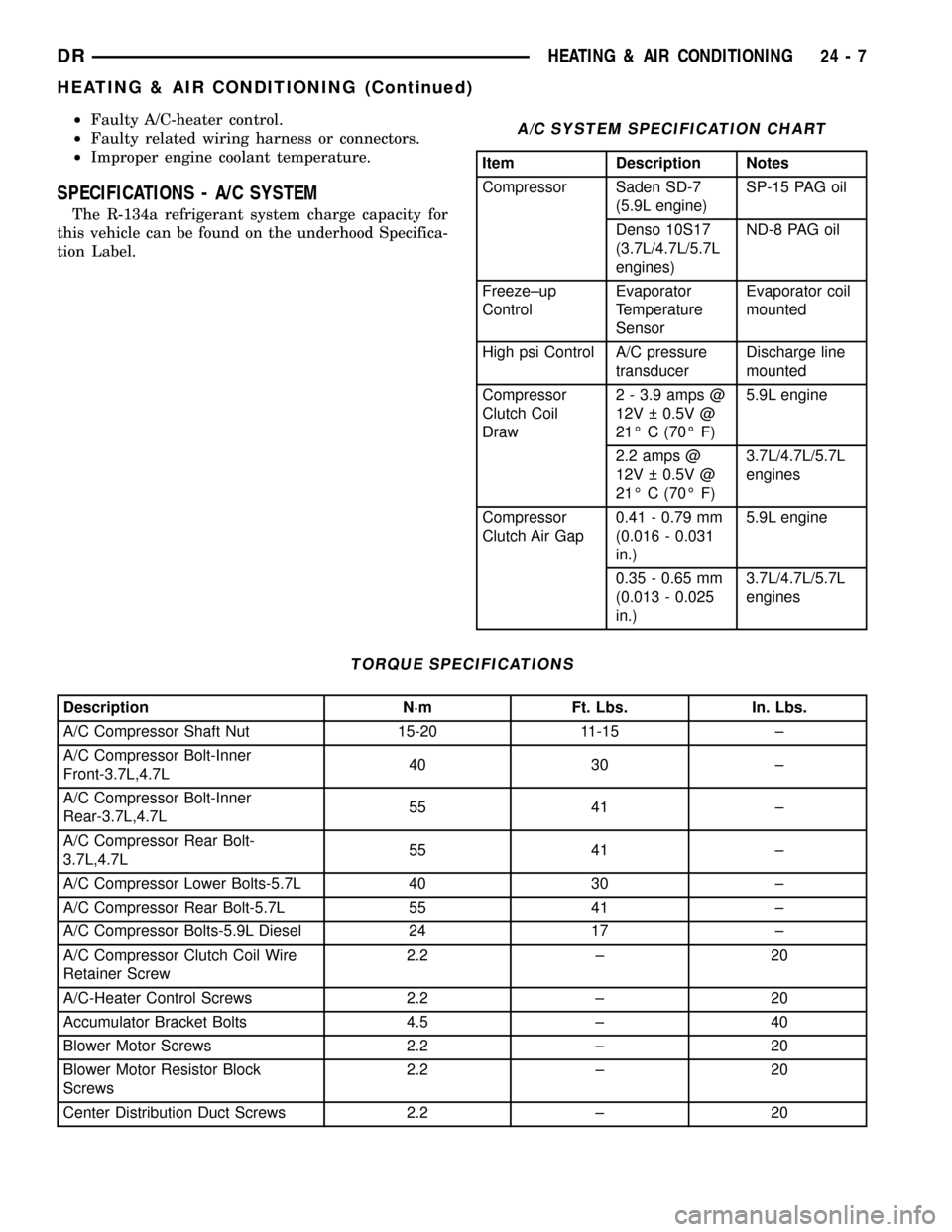harness DODGE RAM 1500 1998 2.G Workshop Manual
[x] Cancel search | Manufacturer: DODGE, Model Year: 1998, Model line: RAM 1500, Model: DODGE RAM 1500 1998 2.GPages: 2627
Page 2374 of 2627

Inertia Hinge
(1) Remove the seat back inertia hinge cover.
(Refer to 23 - BODY/SEATS/CENTER SEAT BACK
INERTIA HINGE COVER - REMOVAL)
(2) Remove and discard the inertia hinge bolts and
remove the hinge. (Fig. 10)
INSTALLATION
NOTE: Do not reuse the seat fasteners, always
replace with new ones.
Free Pivot Hinge/Cover
(1) Position the pivot hinge cover over the pivot
hinge and install the 12v power supply harness into
the channel, if equipped.
(2) Close the hinge cover flat and position the
spacer into place.
(3) Align the stop pin with the spacer and hinge
and install the assembly onto the seat back.
(4) Install a new pivot bolt and tighten to 25 N´m
(18 ft. lbs.)
Inertia Hinge
(1) Install the inertia hinge onto the center seat
back and install new bolts.
(2) Tighten the bolts to 25 N´m (18 ft. lbs.).
(3) Install the seat back inertia hinge covers.
(Refer to 23 - BODY/SEATS/CENTER SEAT BACK
INERTIA HINGE COVER - INSTALLATION)
(1) Install the center seat back. (Refer to 23 -
BODY/SEATS/CENTER ARMREST / SEAT BACK -
INSTALLATION)
CENTER SEAT BACK LID
REMOVAL
(1) Open the center armrest/seat back.
(2) Remove the four screws attaching the hinge to
the storage bin/cushion and remove the lid.
INSTALLATION
(1) Position the center seat back lid onto the stor-
age bin/cushion and install the screws.
CENTER SEAT CUSHION
REMOVAL
(1) Remove the center seat. (Refer to 23 - BODY/
SEATS/CENTER SEAT - REMOVAL)
(2) Remove the center armrest/seat back. (Refer to
23 - BODY/SEATS/CENTER ARMREST / SEAT
BACK - REMOVAL)
INSTALLATION
(1) Install the center armrest/seat back. (Refer to
23 - BODY/SEATS/CENTER ARMREST / SEAT
BACK - INSTALLATION)
(2) Install the center seat. (Refer to 23 - BODY/
SEATS/CENTER SEAT - INSTALLATION)
CENTER SEAT CUSHION
COVER
REMOVAL
(1) Remove the center seat cushion or underseat
storage bin lid. (Refer to 23 - BODY/SEATS/CENTER
SEAT CUSHION/UNDERSEAT STORAGE BIN LID
- REMOVAL)
(2) Disconnect the zip strips and remove the cover
from the cushion.
INSTALLATION
(1) Install the cover over the center seat cushion
and connect the zip strips.
(2) Install the center seat cushion or under seat
storage bin lid. (Refer to 23 - BODY/SEATS/CENTER
SEAT CUSHION/UNDER SEAT STORAGE BIN LID
- INSTALLATION)
Fig. 10 INERTIA HINGE BOLTS
1 - SEAT BACK BOLTS
2 - CENTER SEAT BACK
3 - INERTIA HINGE
DRSEATS 23 - 79
CENTER SEAT BACK HINGE (Continued)
Page 2376 of 2627

HEADREST SLEEVE
REMOVAL
(1) Remove the headrest. (Refer to 23 - BODY/
SEATS/HEADREST - REMOVAL)
(2) Grasp the sleeves and pull up and out of the
seat back to remove.
INSTALLATION
(1) Position each headrest sleeve into correct seat
back hole and press into place fully.
(2) Install the headrest. (Refer to 23 - BODY/
SEATS/HEADREST - INSTALLATION)
SEAT - FRONT
REMOVAL
NOTE: Do not reuse the seat fasteners, always
replace with new ones.
(1) Remove and discard the front bolts. (Fig. 12)
(2) Position the seats forward, remove the rear
bolts and discard.
(3) Disconnect the 12v power supply electrical con-
nector, if equipped. (Fig. 13)
(4) Fold the seat backs forward and roll the seat
assembly back in the vehicle.
(5) Separate the seat assembly by removing and
discarding the three nuts on either the drivers or
passengers seat. (Fig. 14)
(6) Remove each section of the seat assembly from
the vehicle.
INSTALLATION
NOTE: Do not reuse the seat fasteners, always
replace with new ones.
(1) Position each seat section into the vehicle and
tip back.Fig. 12 FRONT SEAT ASSEMBLY
1 - FRONT SEAT ASSEMBLY
2 - REAR BOLTS (4)
3 - ELECTRICAL CONNECTOR
4 - FRONT BOLTS (4)
Fig. 13 CENTER SEAT ATTACHMENTS
1 - CENTER SEAT ASSEMBLY
2 - FRONT NUTS (2)
3 - POWER SUPPLY ELECTRICAL CONNECTOR
4 - REAR NUTS (4)
5 - 12V POWER SUPPLY HARNESS
Fig. 14 REAR ATTACHMENTS
1 - 12V POWER SUPPLY HARNESS
2 - CENTER SEAT STORAGE BIN
3 - FRONT SEAT TRACKS
4 - REAR NUTS (4)
DRSEATS 23 - 81
Page 2494 of 2627

²Faulty A/C-heater control.
²Faulty related wiring harness or connectors.
²Improper engine coolant temperature.
SPECIFICATIONS - A/C SYSTEM
The R-134a refrigerant system charge capacity for
this vehicle can be found on the underhood Specifica-
tion Label.
A/C SYSTEM SPECIFICATION CHART
Item Description Notes
Compressor Saden SD-7
(5.9L engine)SP-15 PAG oil
Denso 10S17
(3.7L/4.7L/5.7L
engines)ND-8 PAG oil
Freeze±up
ControlEvaporator
Temperature
SensorEvaporator coil
mounted
High psi Control A/C pressure
transducerDischarge line
mounted
Compressor
Clutch Coil
Draw2 - 3.9 amps @
12V 0.5V @
21É C (70É F)5.9L engine
2.2 amps @
12V 0.5V @
21É C (70É F)3.7L/4.7L/5.7L
engines
Compressor
Clutch Air Gap0.41 - 0.79 mm
(0.016 - 0.031
in.)5.9L engine
0.35 - 0.65 mm
(0.013 - 0.025
in.)3.7L/4.7L/5.7L
engines
TORQUE SPECIFICATIONS
Description N´m Ft. Lbs. In. Lbs.
A/C Compressor Shaft Nut 15-20 11-15 ±
A/C Compressor Bolt-Inner
Front-3.7L,4.7L40 30 ±
A/C Compressor Bolt-Inner
Rear-3.7L,4.7L55 41 ±
A/C Compressor Rear Bolt-
3.7L,4.7L55 41 ±
A/C Compressor Lower Bolts-5.7L 40 30 ±
A/C Compressor Rear Bolt-5.7L 55 41 ±
A/C Compressor Bolts-5.9L Diesel 24 17 ±
A/C Compressor Clutch Coil Wire
Retainer Screw2.2 ± 20
A/C-Heater Control Screws 2.2 ± 20
Accumulator Bracket Bolts 4.5 ± 40
Blower Motor Screws 2.2 ± 20
Blower Motor Resistor Block
Screws2.2 ± 20
Center Distribution Duct Screws 2.2 ± 20
DRHEATING & AIR CONDITIONING 24 - 7
HEATING & AIR CONDITIONING (Continued)
Page 2498 of 2627

(6) Insert the two pins of the spanner wrench
(Special Tool C-4489 or equivalent) into the holes of
the clutch plate. Hold the clutch plate stationary and
remove the hex nut (Fig. 2).
(7) Remove the clutch plate.
(8) Remove the compressor clutch shims.
(9) Remove the external front housing snap ring
with snap ring pliers (Fig. 3).
(10) Install the lip of the rotor puller (Special Tool
C-6141-1 or equivalent) into the snap ring groove
exposed in the previous step, and install the shaft
protector (Special Tool C-6141-2 or equivalent) (Fig.
4).
(11) Install the puller through-bolts (Special Tool
C-6461 or equivalent) through the puller flange and
into the jaws of the rotor puller and tighten (Fig. 5).Turn the puller center bolt clockwise until the rotor
is free.
CAUTION: DO NOT APPLY FORCE TO THE END OF
THE COMPRESSOR SHAFT.
(12) Remove the screw and retainer from the
clutch coil lead wire harness on the compressor front
housing (Fig. 6).
(13) Remove the snap ring from the compressor
hub and remove the clutch field coil (Fig. 7). Slide
the clutch field coil off of the compressor hub.
INSPECTION
Examine the friction surfaces of the clutch pulley
and the clutch plate for wear. The pulley and clutch
plate should be replaced if there is excessive wear or
scoring.
Fig. 2 Clutch Nut Remove - Typical
1 - CLUTCH PLATE
2 - SPANNER
Fig. 3 External Snap Ring Remove - Typical
1 - PULLEY
2 - SNAP RING PLIERS
Fig. 4 Shaft Protector and Puller - Typical
1 - PULLER JAW
2 - SHAFT PROTECTOR
Fig. 5 Install Puller Plate - Typical
1 - PULLER JAW
2 - PULLER
DRCONTROLS 24 - 11
A/C COMPRESSOR CLUTCH/COIL (Continued)
Page 2499 of 2627

If the friction surfaces are oily, inspect the shaft
and nose area of the A/C compressor for oil. Remove
the felt from the front cover. If the felt is saturated
with oil, the shaft seal is leaking and the A/C com-
pressor must be replaced.
Check the pulley bearing for roughness or exces-
sive leakage of grease. Replace the pulley and clutch
plate, if required.
INSTALLATION
(1) Install the clutch field coil and snap ring.
(2) Install the screw and retainer on the clutch coil
lead wire harness on the compressor front housing.
Tighten screw to 2.2 N´m (20 in. lbs.).
(3) Align the rotor assembly squarely on the front
compressor housing hub.
(4) Install the rotor bearing assembly with the
installer (Special Tool C-6871 or equivalent) (Fig. 8).
Thread the installer on the shaft, then turn the nut
until the rotor assembly is seated.
(5) Install the external front housing snap ring
with snap ring pliers. The bevel side of the snap ring
must be facing outward. Press the snap ring to make
sure it is properly seated in the groove.
CAUTION: If the snap ring is not fully seated in the
groove it will vibrate out, resulting in a clutch fail-
ure and severe damage to the front housing of the
compressor.
(6) Install the original clutch shims on the com-
pressor shaft.
(7) Install the clutch plate. Install the shaft hex
nut and tighten to 15±20 N´m (11±15 ft. lbs.).
(8) Check the clutch air gap with a feeler gauge
(Fig. 9). If the air gap does not meet specifications,
add or subtract shims as required (Refer to 24 -
HEATING & AIR CONDITIONING - SPECIFICA-
TIONS).
Fig. 6 Clutch Coil Lead Wire Harness - Typical
1 - COIL
2 - COIL WIRE
3 - RETAINER SCREW
Fig. 7 Clutch Field Coil Snap Ring Remove - Typical
1 - COIL
2 - SNAP RING PLIERS
Fig. 8 Clutch Pulley Install - Typical
1 - ROTOR BEARING ASSEMBLY
2 - INSTALLER
24 - 12 CONTROLSDR
A/C COMPRESSOR CLUTCH/COIL (Continued)
Page 2502 of 2627

The illumination lamps are available for service
replacement.
REMOVAL
WARNING: ON VEHICLES EQUIPPED WITH AIR-
BAGS, DISABLE THE AIRBAG SYSTEM BEFORE
ATTEMPTING ANY STEERING WHEEL, STEERING
COLUMN, OR INSTRUMENT PANEL COMPONENT
DIAGNOSIS OR SERVICE. DISCONNECT AND ISO-
LATE THE BATTERY NEGATIVE (GROUND) CABLE,
THEN WAIT TWO MINUTES FOR THE AIRBAG SYS-
TEM CAPACITOR TO DISCHARGE BEFORE PER-
FORMING FURTHER DIAGNOSIS OR SERVICE. THIS
IS THE ONLY SURE WAY TO DISABLE THE AIRBAG
SYSTEM. FAILURE TO TAKE THE PROPER PRE-CAUTIONS COULD RESULT IN AN ACCIDENTAL
AIRBAG DEPLOYMENT AND POSSIBLE PERSONAL
INJURY.
(1) Disconnect and isolate the battery negative
cable.
(2) Remove the center bezel from the instrument
panel (Refer to 23 - BODY/INSTRUMENT PANEL/
INSTRUMENT PANEL CENTER BEZEL -
REMOVAL).
(3) Remove the screws that secure the A/C-heater
control to the instrument panel (Fig. 14).
INSTALLATION
(1) Position the A/C-heater control onto the instru-
ment panel center bezel and install the retaining
screws. Tighten the screws to 2.2 N´m (20 in. lbs.).
(2) Install the instrument panel center bezel (Refer
to 23 - BODY/INSTRUMENT PANEL/INSTRUMENT
PANEL CENTER BEZEL - INSTALLATION).
(3) Reconnect the battery negative cable.
A/C PRESSURE TRANSDUCER
DESCRIPTION
The A/C pressure transducer is a switch that is
installed on a fitting located on the refrigerant dis-
charge line between the compressor and the con-
denser in the front corner of the engine
compartment. An internally threaded hex fitting on
the transducer connects it to the externally threaded
Schrader-type fitting on the discharge line. A rubber
O-ring seals the connection between the transducer
and the discharge line fitting. Three terminals within
a molded plastic connector receptacle on the top of
the transducer connect it to the vehicle electrical sys-
tem through a wire lead and connector of the head-
lamp and dash wire harness.
Fig. 12 Single Zone HVAC Control
1 - MOUNTING TAB (4)
2 - A/C BUTTON
3 - SIDEVIEW MIRROR DEFROSTER BUTTON (IF EQUIPED)
4 - MODE CONTROL SWITCH
5 - TEMPERATURE CONTROL SWITCH
6 - BLOWER MOTOR SWITCH
Fig. 13 Dual Zone A/C Control
1 - A/C BUTTON
2 - MAX. A/C BUTTON
3 - SIDEVIEW MIRROR DEFROSTER BUTTON (IF EQUIPED)
4 - MOUNTING TABS (4)
5 - DRIVERSIDE TEMPERATURE CONTROL
6 - PASSENGERSIDE TEMPERATURE CONTROL
7 - MODE CONTROL SWITCH
8 - BLOWER MOTOR SWITCH
Fig. 14 A/C-Heater Control - Typical, Rear View
1 - MOUNTING TAB (4)
2 - SCREW (4)
3 - A/C-HEATER CONTROL ELECTRICAL CONNECTOR
4 - HEATED SIDEVIEW MIRROR ELECTRICAL CONNECTOR
5 - A/C-HEATER CONTROL
DRCONTROLS 24 - 15
A/C HEATER CONTROL (Continued)
Page 2503 of 2627

The A/C pressure transducer cannot be adjusted or
repaired and, if faulty or damaged, it must be
replaced.
OPERATION
The A/C pressure transducer monitors the pres-
sures in the high side of the refrigerant system
through its connection to a fitting on the discharge
line. The transducer will change its internal resis-
tance in response to the pressures it monitors. The
Powertrain Control Module (PCM) or the Engine
Control Module (ECM) depending on engine applica-
tion, provides a five volt reference signal and a sen-
sor ground to the transducer, then monitors the
output voltage of the transducer on a sensor return
circuit to determine refrigerant pressure. The PCM/
ECM is programmed to respond to this and other
sensor inputs by controlling the operation of the air
conditioning compressor clutch and the radiator cool-
ing fan to help optimize air conditioning system per-
formance and to protect the system components from
damage. The A/C pressure transducer input to the
PCM/ECM will also prevent the air conditioning com-
pressor clutch from engaging when ambient temper-
atures are below about 10É C (50É F) due to the
pressure/temperature relationship of the refrigerant.
The Schrader-type valve in the discharge line fitting
permits the A/C pressure transducer to be removed
or installed without disturbing the refrigerant in the
system. The A/C pressure transducer is diagnosed
using a DRBIIItscan tool. Refer to the appropriate
diagnostic information.
DIAGNOSIS AND TESTING - A/C PRESSURE
TRANSDUCER
The A/C pressure transducer is tested using a
DRBIIItscan tool. Refer to the appropriate diagnos-
tic information. Before testing the A/C pressure
transducer, be certain that the transducer wire har-
ness connection is clean of corrosion and properly
connected. For the air conditioning system to operate,
an A/C pressure transducer voltage reading between
0.451 and 4.519 volts is required. Voltages outside
this range indicate a low or high refrigerant system
pressure condition to the Powertrain Control Module
(PCM) or Engine Control Module (ECM) depending
on engine application. The PCM/ECM is programmed
to respond to a low or high refrigerant system pres-
sure by suppressing operation of the compressor.
Refer to the A/C Pressure Transducer Voltage chart
for the possible conditions indicated by the trans-
ducer voltage reading.
A/C PRESSURE TRANSDUCER VOLTAGE
CHART
Voltage Possible Indication
0.0 1. No sensor supply voltage from
PCM/ECM.
2. Shorted sensor circuit.
3. Faulty transducer.
0.150 TO 0.450 1. Ambient temperature below
10É C (50É F).
2. Low refrigerant system
pressure.
0.451 TO 4.519 1. Normal refrigerant system
pressure.
4.520 TO 4.850 1. High refrigerant system
pressure.
5.0 1. Open sensor circuit.
2. Faulty transducer.
REMOVAL
NOTE: Note: It is not necessary to discharge the
refrigerant system to replace the A/C pressure
transducer.
(1) Disconnect and isolate the battery negative
cable.
(2) Disconnect the wire harness connector from the
A/C pressure transducer.
(3) Remove the A/C pressure transducer from the
fitting on the discharge line (Fig. 15).
(4) Remove the O-ring seal from the A/C pressure
transducer fitting and discard.
INSTALLATION
NOTE: Replace the O-ring seal before installing the
A/C pressure transducer.
(1) Lubricate a new rubber O-ring seal with clean
refrigerant oil and install it on the A/C pressure
transducer fitting. Use only the specified O-rings as
they are made of a special material for the R-134a
system. Use only refrigerant oil of the type recom-
mended for the A/C compressor in the vehicle.
(2) Install and tighten the A/C pressure transducer
onto the discharge line fitting. The transducer should
be hand-tightened securely onto the discharge line
fitting.
(3) Connect the wire harness connector to the A/C
pressure transducer.
24 - 16 CONTROLSDR
A/C PRESSURE TRANSDUCER (Continued)
Page 2504 of 2627

(4) Reconnect the battery negative cable.
BLEND DOOR ACTUATOR
DESCRIPTION
The blend door actuators are reversible, 12-volt
Direct Current (DC), servo motors. Models with the
single zone heater and air conditioner system have a
single blend door, which is controlled by a single
blend door actuator. Models with the optional dual
zone front heater and air conditioner system have
dual blend doors, which are controlled by two blend
door actuators. The single zone blend door actuator is
located on the driver side end of the HVAC housing,
close to the dash panel. In the dual zone system, the
same blend door actuator used for the single zone
system becomes the driver side blend door actuator,
and is mechanically connected to only the driver side
blend door. In the dual zone system, a second sepa-
rate blend door actuator is also located on the top of
the HVAC housing and is mechanically connected to
only the passenger side blend door.
The blend door actuators are interchangeable with
each other, as well as with the actuators for the
mode door, defrost door and the recirculation door.
Each actuator is contained within an identical blackmolded plastic housing with an integral wire connec-
tor receptacle. Integral mounting tabs allow the
actuator to be secured with three screws to the
HVAC housing. Each actuator also has an identical
output shaft with splines that connects it to the link-
age that drives the proper door. The blend door
actuators do not require mechanical indexing to the
blend door linkage, as they are electronically cali-
brated by the heater-A/C control module. The blend
door actuators cannot be adjusted or repaired and, if
damaged or faulty, they must be replaced.
OPERATION
Each blend door actuator is connected to the A/C-
heater control through the vehicle electrical system by a
dedicated two-wire lead and connector from the HVAC
wire harness. The blend door actuator can move the
blend-air door in two directions. When the A/C-heater
control pulls the voltage on one side of the motor con-
nection high and the other connection low, the blend-air
door will move in one direction. When the A/C-heater
control reverses the polarity of the voltage to the motor,
the blend-air door moves in the opposite direction.
When the A/C-heater control makes the voltage to both
connections high or both connections low, the blend-air
door stops and will not move. The motor connections
also provide a feedback signal to the A/C-heater control.
This feedback signal allows the A/C-heater control to
monitor the operation and relative positions of the blend
door actuator and the blend-air door. The A/C-heater
control learns the blend door stop positions during the
calibration procedure and will store a diagnostic trouble
code (DTC) for any problems it detects in the blend door
actuator circuits.
The blend door actuator can be diagnosed using a
DRBIIItscan tool. Refer to Body Diagnostic Proce-
dures for more information. The blend door actuators
cannot be adjusted or repaired and, if damaged or
faulty, they must be replaced.
REMOVAL
WARNING: ON VEHICLES EQUIPPED WITH AIR-
BAGS, DISABLE THE AIRBAG SYSTEM BEFORE
ATTEMPTING ANY STEERING WHEEL, STEERING
COLUMN, OR INSTRUMENT PANEL COMPONENT
DIAGNOSIS OR SERVICE. DISCONNECT AND ISO-
LATE THE BATTERY NEGATIVE (GROUND) CABLE,
THEN WAIT TWO MINUTES FOR THE AIRBAG SYS-
TEM CAPACITOR TO DISCHARGE BEFORE PER-
FORMING FURTHER DIAGNOSIS OR SERVICE. THIS
IS THE ONLY SURE WAY TO DISABLE THE AIRBAG
SYSTEM. FAILURE TO TAKE THE PROPER PRE-
CAUTIONS COULD RESULT IN ACCIDENTAL AIR-
BAG DEPLOYMENT AND POSSIBLE PERSONAL
INJURY.
Fig. 15 A/C Pressure Transducer - 3.7L Shown
1 - NUT
2 - FRONT UPPER CROSSMEMBER
3 - A/C CONDENSER
4 - NUT (2)
5 - SUCTION LINE
6 - A/C COMPRESSOR
7 - A/C PRESSURE TRANSDUCER
8 - WIRE HARNESS CONNECTOR
9 - A/C DISCHARGE LINE
DRCONTROLS 24 - 17
A/C PRESSURE TRANSDUCER (Continued)
Page 2505 of 2627

NOTE: The single zone heating and air conditioning
system is equipped with a single blend door actua-
tor. The dual zone system has two blend door
actuators, one for the driver side blend air door and
one for the passenger side blend air door. The
same service procedures can be used for each of
these actuators.
(1) Disconnect and isolate the battery negative
cable.
(2) Remove the instrument panel from the vehicle
(Refer to 23 - BODY/INSTRUMENT PANEL/IN-
STRUMENT PANEL ASSEMBLY - REMOVAL).
(3) Disconnect the wire harness connector from the
blend door actuator(s) (Fig. 16).
(4) Remove the screws that secure the blend door
actuator(s) to the HVAC housing.
(5) Remove the blend door actuator(s) from the
HVAC housing.INSTALLATION
(1) Position the blend door actuator(s) into the
HVAC housing. If necessary, rotate the actuator(s)
slightly to align the splines on the actuator output
sleeve(s) with those on the blend door linkage.
(2) Install and tighten the screws that secure the
blend door actuator(s) to the HVAC housing. Tighten
the screws to 2 N´m (17 in. lbs.).
(3) Connect the HVAC wire harness connector to
the blend door actuator(s).
(4) Install the instrument panel (Refer to 23 -
BODY/INSTRUMENT PANEL/INSTRUMENT
PANEL ASSEMBLY - INSTALLATION).
(5) Reconnect the battery negative cable.
BLOWER MOTOR RESISTOR
BLOCK
DESCRIPTION
The blower motor resistor is mounted to the bot-
tom side of the HVAC housing near the blower motor.
It can be accessed for service from underneath the
instrument panel.
OPERATION
The resistor has multiple resistor wires, each of
which will reduce the current flow to the blower
motor to change the blower motor speed by changing
the resistance in the blower motor ground path. The
blower motor switch directs the ground path through
the correct resistor wire to obtain the selected speed.
With the blower motor switch in the lowest speed
position, the ground path for the motor is applied
through all of the resistor wires. Each higher speed
selected with the blower motor switch applies the
blower motor ground path through fewer of the resis-
tor wires, increasing the blower motor speed. When
the blower motor switch is in the highest speed posi-
tion, the blower motor resistor is bypassed and the
blower motor receives a direct path to ground.
The blower motor resistor cannot be repaired and,
if faulty or damaged, it must be replaced.
Fig. 16 HVAC Housing - Dual Zone Shown, Single
Zone Typical
1 - NUT
2 - PASSENGER BLEND DOOR ACTUATOR
3 - NUT
4 - INLET BAFFLE
5 - RECIRCULATION DOOR ACTUATOR
6 - RECIRCULATION DOOR
7 - DRIVER SIDE BLEND DOOR ACTUATOR
8 - HVAC HOUSING
9 - BOLT
10 - DEFROSTER DOOR ACTUATOR
11 - MODE DOOR ACTUATOR
24 - 18 CONTROLSDR
BLEND DOOR ACTUATOR (Continued)
Page 2506 of 2627

DIAGNOSIS AND TESTING - BLOWER MOTOR
RESISTOR BLOCK
WARNING: ON VEHICLES EQUIPPED WITH AIR-
BAGS, DISABLE THE AIRBAG SYSTEM BEFORE
ATTEMPTING ANY STEERING WHEEL, STEERING
COLUMN, OR INSTRUMENT PANEL COMPONENT
DIAGNOSIS OR SERVICE. DISCONNECT AND ISO-
LATE THE BATTERY NEGATIVE (GROUND) CABLE,
THEN WAIT TWO MINUTES FOR THE AIRBAG SYS-
TEM CAPACITOR TO DISCHARGE BEFORE PER-
FORMING FURTHER DIAGNOSIS OR SERVICE. THIS
IS THE ONLY SURE WAY TO DISABLE THE AIRBAG
SYSTEM. FAILURE TO TAKE THE PROPER PRE-
CAUTIONS COULD RESULT IN AN ACCIDENTAL
AIRBAG DEPLOYMENT AND POSSIBLE PERSONAL
INJURY.
For circuit descriptions and diagrams, refer to the
appropriate wiring information. The wiring informa-
tion includes wiring diagrams, proper wire and con-
nector repair procedures, further details on wire
harness routing and retention, as well as pin-out and
location views for the various wire harness connec-
tors, splices and grounds.
(1) Disconnect and isolate the negative battery
cable.
(2) Disconnect the wire harness connector from the
blower motor resistor block.
(3) Check for continuity between each of the
blower motor switch input terminals of the resistor
and the resistor output terminal. In each case there
should be continuity. If OK, repair the wire harness
circuits between the blower motor switch and blower
motor resistor or blower motor as required. If not
OK, replace the faulty blower motor resistor block.
REMOVAL
WARNING: ON VEHICLES EQUIPPED WITH AIR-
BAGS, DISABLE THE AIRBAG SYSTEM BEFORE
ATTEMPTING ANY STEERING WHEEL, STEERING
COLUMN, OR INSTRUMENT PANEL COMPONENT
DIAGNOSIS OR SERVICE. DISCONNECT AND ISO-
LATE THE BATTERY NEGATIVE (GROUND) CABLE,
THEN WAIT TWO MINUTES FOR THE AIRBAG SYS-
TEM CAPACITOR TO DISCHARGE BEFORE PER-
FORMING FURTHER DIAGNOSIS OR SERVICE. THIS
IS THE ONLY SURE WAY TO DISABLE THE AIRBAG
SYSTEM. FAILURE TO TAKE THE PROPER PRE-
CAUTIONS COULD RESULT IN AN ACCIDENTAL
AIRBAG DEPLOYMENT AND POSSIBLE PERSONAL
INJURY.CAUTION: Stay clear of the blower motor resistor
block heat sink (Hot). Do not operate the blower
motor with the resistor block removed.
(1) Disconnect and isolate the negative battery
cable.
(2) Reach under the instrument panel near the
blower motor and disconnect the wire harness con-
nector from the blower motor resistor block.
(3) Remove the two screws that secure the blower
motor resistor block to the HVAC housing.
(4) Remove the resistor block from the HVAC
housing.
INSTALLATION
(1) Position the blower motor resistor block into
the HVAC housing.
(2) Install the two screws that secure the resistor
block to the HVAC housing. Tighten the screws to 2.2
N´m (20 in. lbs.).
(3) Connect the wire harness connector to the
resistor block.
(4) Reconnect the battery negative cable.
Fig. 17 Blower Motor Resistor Block
1 - SCREW (2)
2 - WIRE HARNESS CONNECTOR
3 - HVAC HOUSING
4 - BLOWER MOTOR RESISTOR BLOCK
5 - BLOWER MOTOR
DRCONTROLS 24 - 19
BLOWER MOTOR RESISTOR BLOCK (Continued)